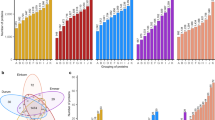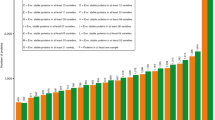Abstract
Wheat-related disorders are well-studied health problems. Knowledge of the composition and amounts of epitopes present in a single wheat sample represents a significant gap, and the detailed wheat proteome datasets now available can provide the necessary information to carry out an estimation of allergen prediction for a single cultivar. The combined use of genome sequence and allergen databases, prediction methodology, and cereal chemistry results in better understanding of the level of toxicity present in the end-products produced from wheat flour. The workflow presented in this review provides information about the number and distribution of epitopes at single protein, or protein fraction, levels. In addition, epitopes present in the highest frequency and harmful proteins expressed in the highest amount can be identified. The “epitope toxicity” value obtained in this way is a significant research output from the analysis of large datasets that can be applied to the food industry.






Similar content being viewed by others
References
Akagawa M, Takeshi M, Shigenori I, Morita N, Suyamato K (2007) Proteomic analysis of wheat flour allergens. J Agric Food Chem 55:6863–6870
Altenbach SB, Kothari KM, Tanaka CK, Hurkman WJ (2007) Genes encoding the PR-4 protein wheatwin are developmentally regulated in wheat grains and respond to high temperatures during grainfill. Plant Sci 173:135–143
Amano M, Ogawa H, Kojima K, Kamidaira T, Suetsugu S, Yoshihama M, Satoh T, Samejima T, Matsumoto I (1998) Identification of the major allergens in wheat flour responsible for baker's asthma. Biochem J 330:1229–1234
Anderson RP, Wieser H (2006) Medical applications of gluten—composition knowledge. In: Wrigley CW, Békés F, Bushuk W (eds) Gliadin and glutenin. The unique balance of wheat quality. AACCI Press, St Paul, pp 387–409
Anderson RP, Degano P, Godkin AJ, Jewell DP, Hill AVS (2000) In vivo antigen challenge in celiac disease identifies a single transglutaminase-modified peptid as the dominant A gliadin T-cell epitope. Nature (Med) 6:337–342
Armentia A, Martin-Santos JM, Blanco M (1990) Exercise induced anaphylaxis reaction to grain flows. Ann Allergy 65:149–151
Bredehorst R, David K (2001) What establishes a protein as an allergen? J Chromatogr B Biomed Sci Appl 756:33–40
Breiteneder H (2008) Can any protein become an allergen? Rev Fr Allergol Immunol Clin 2008(48):135–138
Breiteneder H, Radauer C (2004) A classification of plant food allergens. J Allergy Clin Immunol 113:821–830
Brusic V, Rudy G, Honeyman G, Hammer J, Harrison LC (1998) Prediction of MHC class II-binding peptides using an evolutionary algorithm and artificial neural network. Bioinformatics 14:121–130
Brusic V, Petrovsky N, Zhang G, Bajic VB (2002) Prediction of promiscuous peptides that bind HLA class I molecules. Immunol Cell Biol 80:280–285
Brusic V, Petrovsky N, Gendel SM, Millot M, Gigonzac O, Stelman SJ (2003) Computational tools for the study of allergens. Allergy 58:1083–1092
Brusic V, Bajic VB, Petrovsky N (2004) Computational methods for prediction of T-cell epitopes—a framework for modelling, testing, and applications. Methods 34(4):436–443
Catassi C, Fasano A (2008) Celiac disease. In: Arendt EK, Dal Bello F (eds) Gluten-free cereal products and beverages. Academic Press, San Diego, pp 1–28
Chou PY, Fasman GD (2006) Prediction of the secondary structure of proteins from their amino acid sequence. In: Meister A (ed) Advances in enzymology and related areas of molecular biology, vol 47. John Wiley & Sons, Inc, Hoboken
Davies IW, Leaver-Fay A, Chen VB, Block JN, Kapral GJ, Wang X, Murray LW, Arendall WB, Snoeyink J, Richardson JS, Richardson DC (2007) MolProbity: all-atom contacts and structure validation for proteins and nucleic acids. Nucleic Acids Res 35:W375–W383, 10.1093/nar/gkm216
Donnes P, Elofsson A (2002) Prediction of MHC class I binding peptides, using SVMHC. BMC Bioinformatics 3:25
Doytchinova IA, Walshe V, Borrow P, Flower DR (2005) Towards the chemometric dissection of peptide-HLAA* 0201 binding affinity: comparison of local and global QSAR models. J Comput Aided Mol Des 19:203–212
Dupont FM, Vensel W, Tanaka CK, Hurkman WJ, Altenbach SB (2011) Deciphering the complexities of the wheat flour proteome using quantitative two-dimensional electrophoresis, three proteases and tandem mass spectrometry. Proteome Sci 9:10
Emini EA, Hughes JV, Perlow DS, Boger J (1985) Induction of hepatitis A virus neutralizing antibody by a virus-specific synthetic peptide. J Virol 55:836–839
Garsed K, Scott BB (2007) Can oats be taken in a gluten-free diet? A systematic review. Scand J Gastroenterol 42(2):171–178
Green PH, Cellier C (2007) Celiac disease. N Engl J Med 357:1731–1743. doi:10.1056/NEJMra071600
Henderson KN, Tye-Din JA, Reid HH, Chen Z, Borg NA, Beissbarth T, Tatham A, Mannering SI, Purcell AW, Dudek NL, van Heel DA, McCluskey J, Rossjohn J, Anderson RP (2007) A structural and immunological basis for the role of human leukocyte antigen DQ8 in celiac disease. Immunity 27:23–34
Juhász A, Gy G, Sebestyén E, Haraszi R, Tamás L, Balázs E (2012) Brachypodium distachyon as a model for defining the allergen potential of non-prolamin proteins. Funct Integr Genomics 12:439–446. doi:10.1007/s10142-012-0294-z
Karplus PA, Schultz GE (1985) Prediction of chain flexibility in proteins. Naturwissenschaften 72:212–222
Kolaskar AS, Tongaonkar PC (1990) A semi-empirical method for prediction of antigenic determinants on protein antigens. FEBS Lett 276(1–2):172–174
Laurièrre M, Pecquet C, Bouchez-Mahiout I, Snegaroff J, Bayrou O, Raison-Peyron N, Vigan M (2006) Hydrolyzed wheat proteins present in cosmetics can induce immediate hypersensitivities. Contact Dermatitis 54:283–289
MacNamara A, Kadolsky U, Bangham CRM, Asquith B (2009) T-cell epitope prediction: rescaling can mask biological variation between MHC molecules. PLoS Comput Biol 5(3):e1000327
Mills ENC, Madsen C, Shewry PR, Wichers HJ (2003) Food allergens of plant origin—their molecular and evolutionary relationships. Trends Food Sci Technol 14:145–156
Moolhuijzen P (2011) Bioinformatics approaches for functional predictions in diverse informatics environments. PhD Thesis. Murdoch University, Perth
Osorio C, Wen N, Gemini R, Zemetra R, Wettstein D, Rustgi S (2012) Targeted modification of wheat grain protein to reduce the content of celiac causing epitopes. Funct Interg Genomics 12(3):417–438. doi:10.1007/s10142-012-0287-y
Parker JM, Guo D, Hodges RS (1986) New hydrophilicity scale derived from high-performance liquid chromatography peptide retention data: correlation of predicted surface residues with antigenicity and X-ray-derived accessible sites. Biochemistry 25:5425–5432
Popineau Y, Pineau F (1988) Changes of conformation and surface hydrophobicity of gliadins. Lebensm Wiss Technol 21:113–117
Radauer C, Breiteneder H (2007) Evolutionary biology of plant food allergens. J Allergy Clin Immun 120:518–525
Rammensee H, Bachmann J, Emmerich NP, Bachor OA, Stevanović S (1999) SYFPEITHI: database for MHC ligands and peptide motifs. Immunogenetics 50:213–219
Rigetti AC, Chillemi GF (1978) Isoelectric focusing of peptides. J Chrom 156:243–251
Salcedo G, Quirce S, Diaz-Perales A (2011) Wheat allergens associated with baker’s asthma. J Investig Allergol Clin Immunol 21(2):81–92
Salentijn EMJ, Mitea DC, Goryunova SV, van der Meer IM, Padioleau I, Gilissen LJWJ, Koning F, Smulders MJM (2012) Celiac disease T-cell epitopes from gamma-gliadins: immunoreactivity depends on the genome of origin, transcript frequency, and flanking protein variation. BMC Genomics 13:277
Sampson HA, Metcalfe DD (1992) Food allergies. J Am Med Assoc 268:2840–2844
Sapone A, Bai JC, Ciacci C, Dolinsek J, Green PHR, Hadjivassiliou M, Kaukinen K, Rostami K, Sanders DS, Schumann M, Ullrich R, Villalta D, Volta U, Catassi C, Fasano A (2012) Spectrum of gluten-related disorders: consensus on new nomenclature and classification. BMC Med 10:13. doi:10.1186/1741-7015-10-13
Shan L, Molberg Ø, Parrot I, Hausch F, Filiz F, Gray GM, Sollid LM, Khosla C (2002) Structural basis for gluten intolerance in celiac sprue. Science 297(5590):2275–2279
Shewry PR, Miles MJ, Thomson NH, Tatham S (1997) Scanning probe microscopes—applications in cereal science. Cereal Chem 74:193–199
Shewry PR, D’Ovidio R, Lafiandra D, Jenkins JA, Mills NF, Békés F (2009) Wheat grain proteins. In: Khan K, Shewry PR (eds) Wheat chemistry and technology. AACC Press, St Paul, pp 223–298
Sollid LM, Qiao SW, Anderson RP, Gianfrani C, Koning F (2012) Nomenclature and listing of celiac disease relevant gluten T-cell epitopes restricted by HLA-DQ molecules. Immunogenetics 64:455–460. doi:10.1007/s00251-012-0599-z
Tal M, Silberstein A, Nusser E (1980) Why does Coomassie Brilliant Blue R interact differently with different proteins? A partial answer. Biol Chem 260:9976–9980
Tasleem-Tahir A, Nadaud I, Chambon C, Branlard G (2012) Expression profiling of starchy endosperm metabolic proteins at 21 stages of wheat grain development. J Proteome Res 11:2754–2773
Tatham AS, Shewry PR (2008) Allergens in wheat and related cereals. Clin Exp Allergy 38:1712–1726
Tomar N, De RK (2010) Immunoinformatics: an integrated scenario. Immunology 131:153–168
Van Heel DA, West J (2006) Recent advances in coeliac disease. Gut 55:1037–1046
Van Regenmortel MHV (1996) Mapping epitope structure and activity: from one-dimensional prediction to four-dimensional description of antigenic specificity. Methods 9:465–472
Vogel JP et al (2010) Genome sequencing and analysis of the model grass Brachypodium distachyon. Nature 463:763–768
Wieser H (2008) Detection of gluten. In: Arendt EK, Dal Bello F (eds) Gluten-free cereal products and beverages. Academic Press, San Diego, pp 47–80
Acknowledgments
The authors wish to thank Professor Rudi Appels for the motivating discussions and suggestions during the analyses and the preparation of the manuscript. The Project is supported by the European Union and co-financed by the European Social Fund (grant agreement no. TÁMOP-4.2.2.A-11/1/KONV-2012-0008).
Author information
Authors and Affiliations
Corresponding author
Electronic supplementary material
Below is the link to the electronic supplementary material.
Supplementary Table 1
Epitope lists used in the analyses are presented as IEDB_CD epitopes, IEDB_WA epitopes; core epitopes based on Sollid et al. 2012; predicted T cell epitopes using both Butte86 and Recital protein sets (XLSX 49 kb)
Supplementary Table 3
Distribution of different epitope sets in Butte 86 and Recital databases. CD epitope subtypes containing tTG sites and core epitopes are also represented in separate columns, both for digested and undigested protein sets (XLSX 18 kb)
Rights and permissions
About this article
Cite this article
Juhász, A., Gell, G., Békés, F. et al. The epitopes in wheat proteins for defining toxic units relevant to human health. Funct Integr Genomics 12, 585–598 (2012). https://doi.org/10.1007/s10142-012-0302-3
Received:
Revised:
Accepted:
Published:
Issue Date:
DOI: https://doi.org/10.1007/s10142-012-0302-3




